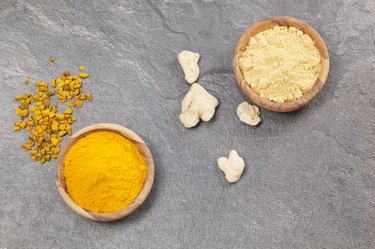
Ginger and turmeric -- common kitchen spices used to flavor and season foods -- have several characteristics in common. Both are tropical perennial plants classified as belonging to the Zingiberacaea family, and both have beneficial constituents in their rhizomes -- or roots -- that cause them to be prized in Traditional Chinese Medicine and Ayurveda as healing herbs. However, ginger and turmeric have different properties, colors, flavors and effects.
Turmeric Features
Video of the Day
Turmeric comes from the plant botanically known as Curcuma longa. Widely cultivated in Asia, India and China, turmeric features oblong leaves and funnel-shaped, dull-yellow flowers. The rhizome -- yellowish on the outside and brilliant orange on the inside -- is dried and powdered to yield the spice. Bitter, pungent and somewhat earthy in flavor, turmeric is a primary ingredient in both mustard and curry. Known as haldi in Ayurveda, turmeric is used to treat jaundice, hepatitis, digestive disorders and inflammatory conditions.
Video of the Day
Turmeric Constituents and Effects
The active ingredient in turmeric is an antioxidant plant pigment called curcumin. Turmeric also contains a compound called zingiberene, which is found in its relative, ginger, as well. Like ginger, turmeric has anti-inflammatory properties, and it is sometimes used to treat inflammatory conditions such as osteoarthritis. Due to curcumin's unique chemical structure, turmeric is an extremely powerful antioxidant. Drugs.com -- which provides peer-reviewed medical information to consumers -- credits turmeric with having wound-healing properties and chemoprotective effects, and reports that turmeric may be helpful in treating cancer, Alzheimer's and Huntingdon's disease. According to the University of Maryland Medical Center, turmeric may be taken as a powder, tincture or fluid extract. Consult your doctor before using turmeric. Don't use turmeric if you are pregnant or breast-feeding.
Ginger Features
Ginger, botanically known as Zingiber officinale, is native to tropical Asia. The rhizome is dried and powdered to create the spice, which is used extensively in baked goods and beverages for its refreshing, pungent flavor; the chopped rhizome may also be consumed fresh. Known as ardraka in Ayurveda, ginger has traditionally been used to treat digestive disorders, particularly nausea and diarrhea; it has also been employed against arthritis and heart conditions.
Ginger Constituents and Effects
Ginger contains over 400 different compounds, including palmitic, oleic, capric and linoleic acids. A sesquiterpene called zingiberene and phenols called gingerols are responsible for most of the therapeutic effects. In a scientific review of herbal anti-inflammatory medications published in 2007 in "Phytotherapy Research," ginger was found to be moderately effective in treating osteoarthritis and low back pain, with at least one confirmatory study showing clinically relevant effect. Drugs.com reports that ginger has shown anti-tumor effects in animal studies, and it notes that ginger may also have the ability to stop platelets from sticking together, making it potentially useful in preventing and treating atherosclerosis. Ginger is also an antiemetic, helping to alleviate nausea. Ginger may be taken in dosages of 250 milligrams to 1 gram three to four times a day. Consult your doctor before using ginger.
- Drugs.com: Complete Turmeric Information
- University of Maryland Medical Center; Turmeric; David Zieve, MD, MHA, and David R. Eltz; August 2010
- Drugs.com: Complete Ginger Information
- Phytotherapy Research: Evidence of Effectiveness of Herbal Antiinflammatory Drugs in the Treatment of Painful Osteoarthritis and Chronic Low Back Pain; J.E. Chrubasik, et al.; July 2007